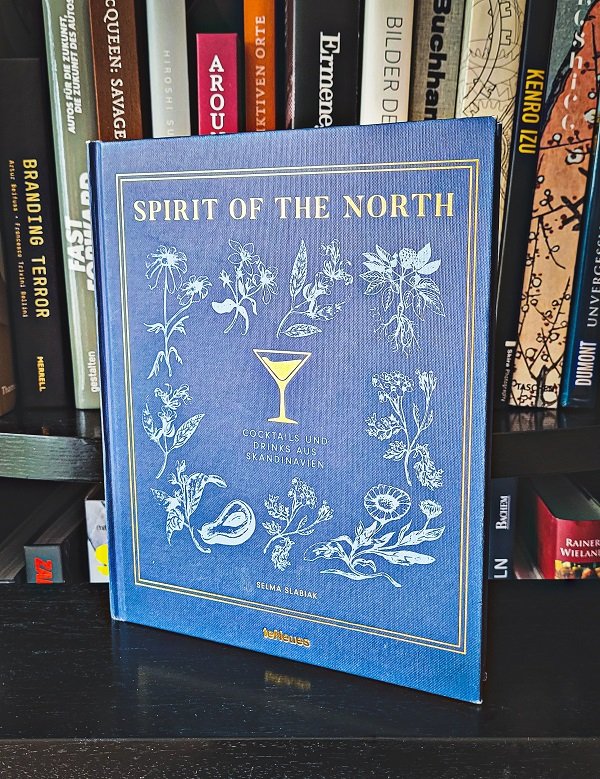Spirit Of The North - Selma Slabiak
Spirit of the North - Cocktail Recipes and Stories from Scandinavia
Selma Slabiak / 160 Pages / October 2018
(Review version: German)
Selma Slabiak's book is full of personality and obviously written with a lot of love. At the same time, it's not the easiest recommendation for the average cocktail enthusiast. Why? Let's start from the beginning:
The passion for the book can be seen immdediately, teNeues published here with the author an attractive and high-quality designed and solidly crafted book, beautiful details on the cover, nice matte paper with a certain feel inside, the very clear and easily understandable layout & structure are some more positive aspects.
The impression that this is a more personal recipe book is evident from the dedication to her grandmother on the first page. In the preface, Slabiak intimately describes her inspiration from that important woman in her life, how she grew up around her in the kitchen, and how she was told about the Nordic legends of her homeland. As you will experience in the book later too , she explains that she "always liked to combine work with storytelling," even when she left Scandinavia to bartend in NYC in 2007.
So each drink in the book is also dedicated to a story or an idea from a legend.
Before the cocktails begin, there is one page each about:
Hygge (the famous Nordic feeling of coziness and how to connect, create and enjoy it with this book).
Basics (the 4-5 most important gadgets, as well as the most important 4-5 tips for preparation, absolutely minimalistic and for actual beginners a bit poor to be honest)
Preserving (not really a how-to, more a description of how a lot of preserving has always been done in the north and that you can do it with a lot of stuff)
Collecting (the same here, rather motivational and inspirational text, instead of any guide, with the important advice to always have an illustrated plant identification book with you while collecting)
This is followed by a double page about just 5 syrups/tinctures for the book, after that come the recipes.
The different chapters are themed after the 4 seasons (Herbst = Fall)
The recipe collection is divided into the 4 seasons as seen above, not just by taste, but quite coherently and sensibly by seasonal ingredients in the drinks. It is far from the only or first book (let alone menu) with this idea, but it feels very authentic here.
What is very attractive and almost wasteful and I as far as I remember have never seen, really every recipe is offered equal space and this is a whopping 4 pages each.
These always consist of first a double page only with the accompanying text, so to speak, the story behind the drink, usually a Nordic legend, inspiration or even personal memory of moments in her homeland, which have to do with an ingredient of the drink. In addition, a "mood photo" and then on the following double page the recipe itself including the drink photo. Those are really aesthetically pleasing and partly also very artistically & elaborately staged.
An example from the recipes, the first double page with the text & mood picture
The double page with the recipe itself, you can find the Freydis here
As is often the case with regionally or nationally inspired cocktail books or recipe collections like this one, the problem is that the techniques themselves or even equipment used tend to be in the low difficulty range, but quite a few ingredients will not be readily or even locally available e.g. here in Germany (or many other countries).
In total, there are 27 recipes described by the book itself as "cocktail". This does not sound like much but feels - because of the presentation with a lot of space for each one - as if there were more. Why I use the therm "cocktail" so specifically? Between the cocktails with their 4 pages there are a few (3-4) food recipes from the Nordic cuisine, especially with syrups/shrubs or the like made for it. Which are also again in between additionally explained with recipes and then also occur in a drink or can of course be simply topped up with soda or something similiar for non-alcoholic drinks. In addition, there are 3-4 non-alcoholic drinks in the direction of punches, which are not called a cocktail in the book, a "Christmas Aquavit", which is basically an extensive aquavit infusion, does not occur specifically in a drink, but can be understood basically as a bottled cocktail, etc. So some additional variety is provided.
I have worked through the book to categorize the cocktail recipes into the two important categories (can be done without/with significant effort):
13-14 recipes (depending on how you count plus-minus 1 or 2), so pretty much half of them, can be prepared with a trip to a well-stocked supermarket. We are talking about rhubarb, cranberries, chamomile flowers (just get tea), including drinks that already use more special, but somewhat common liqueurs / spirits like Byrrh or Strega and ignoring special brand names (just use another aquavit with similar notes or other Highland Scotch instead of this special Highland Park bottling), also including recipes where you have sometimes 4-5 things just for one drink, but which are easy to get in the supermarket (anise, cardamom, etc.)
the rest is divided into various types of recipes and special ingredients, we have wildflower negronis with chamomile, chrysanthemums and geraniums, Meyer lemons, which are simply very rare to get in Germany, spruce needles (for a syrup in the drink), more special liqueurs / spirits such as Björk, Bäska Snaps, etc.
It should be stressed that, in the worst case, online you will get most (at a price) of the things and the techniques themselves remain almost exclusively very simple, maceration, boiling, etc.
After the recipes comes a little one-page biography of Ms. Slabiak, an acknowledgement and then more book recommendations, which I found amusingly random. Although there are also 2-3 books specifically for collecting herbs, etc. for cooking / drinks, but e.g. also Liquid Intelligence by Mr. Arnold or a very general bar book, Ms. Slabiak probably knows herself what I'll also conclude in my following conclusion.
Conclusion:
Artistically very appealing, with a nice personal touch, stringent in the layout, almost lavish, Salbiak's book is nevertheless a not-so-easy case for a clear recommendation. I'm a little surprised that especially in a book with such devotion to her own culture contained in the small amount of text, not a little more effort has gone into things such as interesting, entertaining education on the subject of aquavit or Scandinavian drinking culture, or even, for example, to give at least the most important information for those interested in gathering ingredients in nature, as well as many more topics that would come to mind here.
So, after some thinking, I get the feeling (also recognizable from the book recommendations by herself) that the clear plan here was to create an inexpensive, not too elaborate, but sweetly designed book that would be a typical little bring-along gift from the bookstore. In that sense it succeeds and would be a recommendation. For people who know an acquaintance is either interested in drinks or Scandinavian cuisine. It is definitely not an attempt to create a halfway impressive book about Scandinavian (drinking) culture, botanical cocktails, or other potentially interesting topics. It offers "only" small, admittedly quite inspiring and aesthetically nice views into Scandinavia through the drinks and short accompanying texts, mostly withough actual information content. At no time will you regret the little money that you paid for this book made with some love, just the photos and nice texts to the drinks were worth it to me personally. However, you should know what you are getting into. Also, it's nothing for cocktail beginners, since no real bar basics are explained.





